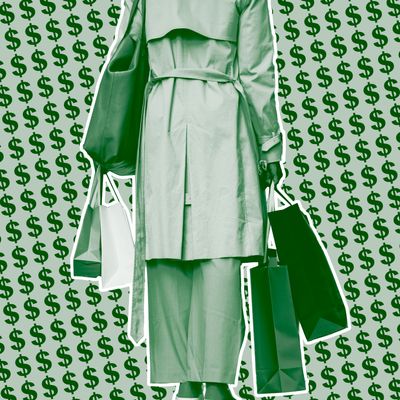
Chrissie Milan has always loved fashion, but earlier this year, she realized her shopping habits were getting out of hand. “If I had an event to go to, instead of planning an outfit ahead of time or looking at what I already had, I’d just buy something new a few days before,” she says. As a result, her closet was jammed with stuff and she was spending more money than she wanted to admit (or could keep track of). “It just didn’t feel responsible, financially or otherwise,” she says. “I felt very out of control.”
Chrissie researched ways to budget better, but most of the advice she found came from people whose lives looked very different from hers. She couldn’t relate to their austere, cook-at-home, capsule-wardrobe lifestyles; she’s a 26-year-old video producer in London and spends most evenings out with friends or working late. “I love dressing up and going places. I love getting my nails done. I love seeing friends, and I go to a lot of events,” she says. “I wanted to still do those things, but in a way that involved consuming less.”
At first, she went cold turkey and tried a strict shopping ban — no new clothes, full stop. It was okay at the beginning — especially since it helped her save about $2,000 in four months — but then it started to feel depressing. Clothes brought her a lot of joy, and while it was nice to find new ways to wear the things she already owned, she didn’t want to opt out of shopping entirely just for the sake of restriction. After six months, she ended the ban and bought a few things she’d been eyeing: a new pair of jeans, shoes, some jewelry. She’s happy with her purchases, and they didn’t wreak havoc on her budget. But she’s still learning to find the middle ground between shopping impulsively and not at all. “I wish there were more models for people who are doing proper financial planning and still living the type of life I want to live,” she says.
She’s not alone — most Americans wish they had a better relationship with shopping and feel torn between the novelty of something new and the reality of what they already have. For those who enjoy getting dressed and browse clothing almost as a hobby (or their actual jobs, if they work in a fashion-related industry), it’s hard to avoid overdoing it, especially at this time of year. The sales are so good! The back-to-school shopping urge is strong! The targeted ads are relentless! The internet becomes a financial minefield.
Anna Newton, who runs a fashion newsletter called The Wardrobe Edit, recently wrote about struggling to resist the shopping vortex. She recommends “alternative ways to scratch the itch” — small, doable tasks that can provide an equal (if not better) rush of satisfaction, like tidying up your closet (no need to go full Marie Kondo; just take 20 minutes to hang and fold everything neatly), ironing or steaming wrinkly clothes, weeding out-of-season items and putting them in a storage bin, or making a digital mood board of outfits in lieu of actually purchasing them.
Marielle Elizabeth Terhart, a photographer and plus-size fashion consultant, admits that she has trouble with this too. “Sometimes things I’ve ordered show up in the mail and I’m not even excited to open them anymore,” she says. “That usually means I need to put myself in time out for a while, take a break from shopping and find some other ways to get that dopamine hit.”
It’s tough, though, when her job is literally to look at clothes and think about them all day. “I am constantly online looking at trend cycles and translating them through the lens of my size and other plus-size people,” she says. “I spend a lot of time scouring the internet to find things that excite me and that inspire me, and the first thought that follows is, Do I need this in my life now?”
Of course, the more time she spends looking, the more likely the answer is “yes.” So she’s devised a set of ways to check herself — she thinks of them as “mental barriers,” or methods to reduce her consumption (and spending). They’re not completely foolproof, she says, but they do help.
1.
Run the item you want past a trusted third party.
This is what group chats are for. “I encourage people to find a few close friends who know what your goals are, know your personal style, and are willing to gently hold you accountable when you really want something,” she says. “I have one friend who’s great at this. I’ll text her a link and she’ll be like, ‘You already own that’ or ‘Where on earth are you going to wear it?’ And she’s always right.”
Even if you don’t have someone who truly gets your style, seeking a second opinion can help you think harder about why you actually want something or slow you down enough to think better of it.
Another way that Terhart applies the third-party rule is to think of herself as a costume designer for her own life. “I know it sounds cheesy, but it helps me zoom out,” she says. “I think, If I were a costume designer on a film set, dressing the character of myself, would I pull this piece for her wardrobe? Will the actor be comfortable in it? It’s a way of taking a step back and removing some of my emotions from the decision.”
2.
See if it fits into your “outfit categories.”
“I’ve learned that there are four types of outfits I actually wear, and if an item doesn’t fall easily into one of those categories, I’m just not going to wear it enough to justify spending money on it,” says Terhart. Each person’s outfit categories are different, she adds, and they will change as you go through different stages of your life. But it’s worth putting some effort into understanding your own.
For reference, Terhart’s are: (1) casual, everyday outfits for running errands and seeing friends, (2) elevated outfits for going to events or being photographed, (3) comfortable, professional clothing for when she’s doing her photography work and needs “to be able to lie on the floor but still look put together,” and (4) loungewear, athleisure, and workout attire.
“If the item I want falls outside of those categories, the reality is I shouldn’t buy it and I can admire it instead,” she says. “At this point in my life, I don’t need first-date clothes. I don’t need going-to-the-bar clothes. And it’s helpful to remember that.”
3.
Explore other ways to get the look you’re going for.
There’s often a lower-lift way to test-run an outfit or trend that appeals to you. “For example, if you really like the trend of red accessories, do you need to buy a $500 bag or can you buy a pair of red socks?” says Terhart.
She also recommends trying to re-create a look with your existing wardrobe before you spring for anything new. “Look at photos or watch runway shows and then go back to your closet and see what closely aligns with it,” she says. Don’t be afraid to dye, tailor, or otherwise repurpose stuff you already have. For instance, Terhart recently took an old pair of shorts and dyed them burgundy to wear in the fall. “I’ve worn them five or six times since I’ve dyed them, whereas before that I’d only worn them twice,” she says. “I think sometimes the urge to keep your clothes pristine can backfire — when you’re too precious with your clothes, you don’t make them your own. I would rather wear them into the ground and enjoy them than keep them perfect in my closet.”
4.
Make peace with the fact that your life will be just as good without it.
“As a plus-size person working in the fashion industry, my relationship with clothing is often fraught with scarcity,” says Terhart. “There’s this feeling of, Oh, if I don’t buy this right now, I might never find it again, and I will miss out on this experience that I want. It creates this almost visceral panic response.”
Instead of caving to that feeling of scarcity, however, Terhart is leaning into a more optimistic view. “It might sound obvious, but I have to remind myself that I can appreciate things without owning them. I can put them on a mood board, or send a link to a friend, or recommend them to someone else,” she says. “I won’t actually be missing out. There will always be more beautiful clothes in the future.”
Email your money conundrums to mytwocents@nymag.com (and read our submission terms here.)
More From This Series
- How Do I Know If I’m Financially Prepared to Have a Baby?
- How Much Does It Actually Cost to Give Birth?
- What It’s Like Being a Billionaire’s Personal Assistant





